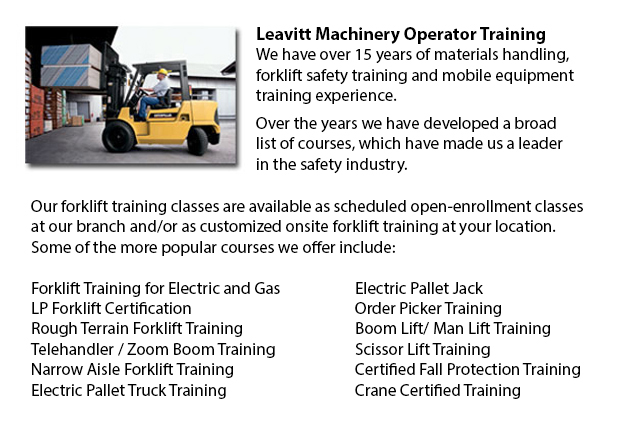
Rough Terrain Forklifts Training Ottawa - There are in fact two different classifications of forklifts within the materials handling market, the industrial model and the rough terrain model. Rough terrain lift trucks first arrived on the market in the 1940's and were predominantly used on irregular roads, ideal for areas where no covered roads were accessible, like construction sites and lumberyards.
Typically, nearly all rough terrain forklifts are run on a propane, diesel or gasoline driven internal combustion engines with a battery used for power. A number of manufacturers are experimenting with rough terrain forklifts that consume vegetable matter and run from ethanol. Huge pneumatic tires with deep treads typify these lift trucks to allow them to latch onto the roughest soil type without any slippage or sliding.
The earliest styles of all terrain forklifts were able to transport weights of up to 1000 lbs, via forks that could slide under the item, raise it a little bit and then transport it to another location. After a decade on the market, rough terrain forklifts were given additional shipping power to about 2000 lbs capacity. Telescoping booms were added in the 1960’s, enabling them to stack materials much higher than in previous years. The telescoping model feature is a staple of most all terrain lift trucks these days. Present versions are capable of managing well over 4000 lbs thanks to the constant improvements through the years. Telescoping capability has also improved with some versions achieving a height of 35 feet. Operator safety has also become a focus with many rough terrain forklifts now developed are equipped with an enclosed cab for the driver, as opposed to the older open air seating capacity.
The all terrain lift trucks existing these days work equally as well on paved floors as on unpaved surfaces. These all terrain forklifts are being marketed for their usefulness enabling companies to move parts from outside the plant to the inside or vice versa.
-
Scissor Lifts
Scissor Lift Training Ottawa - The scissor lift, often acknowledged as a table lift, is an industrialized lift that has been customized for use within wholesale and retail environments. Mechanized lifts have been used for decades in the manufacturing... More -
Clark Forklift
Clark Forklift Forklift Training - Performing globally, there are currently 350,000 Clark forklifts and lift vehicles in operation, with in excess of 250,000 of those in commission in North America. Clark has five main lines of forklifts across the w... More -
Pallet Stackers
Pallet Stackers Training Ottawa - Pallet stackers are a style of pallet jack that can be used to stack, transport and haul merchandise placed on a pallet that are far too burdensome for manual lifting. Mostly these mechanisms are employed to load and... More -
Pallet Lifts
Pallet Lifts Training Ottawa - A pallet lift is a device intended in particular for transporting pallets of varying weights and sizes. They might be utilized in conjunction with cranes, platform lifts and other heavy duty equipment as an appendage pi... More -
Reach Trucks
Reach Truck Training Ottawa - Reach Trucks are mechanized equipment used for loading and storage in some businesses that maintain storage of supplies to finished merchandise on a pallet which are then placed into lofty shelving units. This loading ap... More

Forklift Training Ottawa
Ottawa, Ontario
forklifttrainingottawa.com
Email Us
About Us


